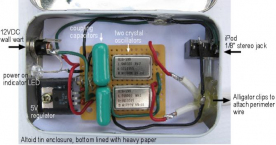Here’s a project I finished to help a friend find a break in her buried-wire dog fence. It employs a DIY AM transmitter designed specifically for this project, and a standard AM radio.
Background: An invisible pet fence is usually a loop of wire, barely underground, acting as an antenna. (There are other types, including a portable transmitter that causes the dog to be zapped when he goes out of range.) The transmitter unit is wired directly to the antenna and placed out of the way, in the garage for instance. The pet wears a receiver on its collar and receives a jolt when it gets too close to the perimeter wire. The signal is probably coded - you wouldn’t want just any broadcast at the right frequency to zap the pet. Many commercial units reportedly broadcasting at 600kHz, others (particularly PetSafe) reportedly at 10.65kHz.
If you have a 600kHz system, there's a popular method for finding a break in the wire loop that involves placing a 100µH RF choke onto the transmitter, in parallel with the broken loop. The transmitter detects a lack of continuity when the perimeter wire loop is broken and sounds an alarm. The low DC resistance of the choke allows the system to continue transmitting without the alarm. But the inductance of the choke presents a high impedance to the RF signal, so the RF signal is sent out over the antenna pieces. You then use a portable AM radio tuned to ~600kHz to scan along your perimeter, listening for the lack of a throbbing signal, indicating the location of the break. Many folks have had luck with this, so I'm sure it works at least for some systems. Note that some write-ups suggest you additionally wrap the ends of the broken loop wire around the leads of the choke before reconnecting to the transmitter, instead of just putting them in parallel. Wrapping the boundary wire leads around the choke leads provides a crude isolation transformer. Pulses through the leads of the choke are picked up by the wrapped wire. Perhaps this increases the signal you would get without wrapping?
I found an old solar light that had a 100µH inductor on it (brown, black, brown, silver, measured resistance at ~3Ω, so it's not a resistor). The technique didn’t work for me though, as my friend’s system is PetSafe, and doesn’t broadcast in the AM band. The PetSafe solution is an expensive (>$50) accessory consisting of a transmitter that generates a two-tone signal in the AM range. It comes with a receiver.
Strategy: So I started thinking about making either a transmitter or a receiver that would allow me to find the break. I soon realized it would be easier to build a transmitter and use a standard AM radio as my break finder.
1) This is simpler than building a receiver for 10.65 kHz, the native PetSafe dog fence frequency. (Which may vary between models.)
2) I can test my transmitter with a standard AM radio at 1000 kHz, and use the same AM radio to find a break in the wire. If I build a receiver for 10.65 kHz, I cannot test it except with the original transmitter, which I cannot assume is working correctly.
3) This solution will work for every buried-wire system since it uses no part of the original system, except the perimeter wire itself.
4) The transmitter strategy is used in the $50 commercial device.
Schematic: The circuit I started with is described here and http://sci-toys.com/scitoys/scitoys/radio/am_transmitter.html. (The second link has better pictures but muddies the purpose of the transformer.)
![[​IMG]](https://web.archive.org/web/20150112162252im_/http://forum.allaboutcircuits.com/attachment.php?attachmentid=36286&d=1320861909)
Note how the high impedance side of the transformer limits power to the oscillator, allowing the pulsing of the audio signal to amplitude-modulate the 1MHz carrier provided by the crystal oscillator.
Since I didn’t have any suitable transformer on hand, I experimented to see if I could replace the audio transformer with a ~1k resistor in series with power to the oscillator, and a capacitor to couple and isolate the audio signal. My concern was not losing fidelity, since I just want to broadcast a continuous tone, say 1 kHz. But I wanted to be sure to not overload my tone source, my iPod’s headphone output, which I think is 32Ω impedance. My iPod survived all this, so I guess it’s safe as shown. Anyway, it worked fine to omit the transformer.
I also wanted to be able to use a wide range of power supplies, so I added a voltage regulator. And, I wanted to put out TWO tones onto the opposite sides of the broken wire. A break in the wire will be detected as a pitch change when you scan over the break, from one tone to the other. This required building two identical AM transmitters. I routed the two stereo channels to the two transmitters.
My final schematic:

![[​IMG]](https://web.archive.org/web/20150112162252im_/http://forum.allaboutcircuits.com/attachment.php?attachmentid=36289&d=1320862041)
The build:
![[​IMG]](https://web.archive.org/web/20150112162252im_/http://forum.allaboutcircuits.com/attachment.php?attachmentid=36287&d=1320861909)
![[​IMG]](https://web.archive.org/web/20150112162252im_/http://forum.allaboutcircuits.com/attachment.php?attachmentid=36298&stc=1&d=1320891064)
![[​IMG]](https://web.archive.org/web/20150112162252im_/http://forum.allaboutcircuits.com/attachment.php?attachmentid=36299&d=1320891064)
To use the device, I made a 6-second “song” containing one tone on the left channel and another on the right. Sorry, but I can’t recall what software I used or what frequencies I used. The Mac application may have been Audio Toolbox. The output was something like a 440Hz sine wave on the left and 1,320Hz on the right. [UPDATE: I since recalled that I used NCH Software's program "ToneGen" - free trial - to generate the sound file, using 440 and 1,760 Hz on the left and right channels respectively.] I recall thinking afterwards that I should have used tones that are NOT in tune with each other to make it easier to tell them apart. I set my iPod to replay the tone song repeatedly and tuned in my AM receiver. (Mine has digital tuning.)
Conclusion: It worked! What more can I say? At the workbench, the transmitter could be detected at least about 10 feet away. Detection distance increased with antenna length. In the field with the buried perimeter wire, the signal was easily detected a foot or two above the ground, by sweeping the receiver back and forth perpendicularly to the wire. I found and repaired the break in minutes.
-
- File size:
- 10.8 KB
- Views:
- 918
-
- File size:
- 37.3 KB
- Views:
- 882
-
- File size:
- 288.7 KB
- Views:
- 102
-
- File size:
- 32.2 KB
- Views:
- 904
-
- File size:
- 270.3 KB
- Views:
- 98
Last edited:Â Nov 28, 2011

